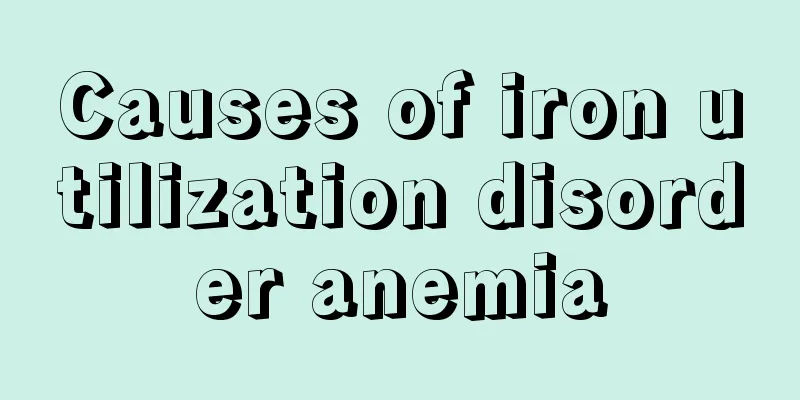Causes of iron utilization disorder anemia

|
Anemia is more common in women. If the nutrition is unbalanced, anemia may occur. Eat more blood-enriching foods, such as red rice, brown sugar water, soy products, vegetables, etc. to maintain a balanced nutrition. Exercise every day to enhance immunity and avoid staying up late. People with chronic blood loss are more common in iron utilization anemia. Let's take a look at the causes of iron utilization anemia. 1. Iron utilization anemia Iron utilization anemia is anemia that occurs when the body's iron stores cannot meet the needs of normal red blood cell production. It is due to insufficient iron intake, reduced absorption, increased iron requirements, iron utilization disorders or excessive loss. The morphological manifestation is microcytic hypochromic anemia. Iron utilization anemia is not a disease, but a symptom of a disease. The symptoms are related to the degree of anemia and the severity of onset. 2. Causes 1. Increased iron requirement and insufficient iron intake: Rapidly growing infants, children, women with heavy menstruation, and women during pregnancy or lactation have increased iron requirements. If iron is lacking in the diet, it can easily lead to iron anemia. 2. Poor iron absorption: It is relatively rare for iron deficiency anemia to occur due to iron absorption disorder. 3. Blood loss: Blood loss, especially chronic blood loss, is the most common and important cause of iron deficiency anemia. Gastrointestinal bleeding such as ulcer disease, cancer, hookworm disease, esophageal varicose bleeding, hemorrhoidal bleeding, antral gastritis after taking salicylates and other diseases that can cause chronic bleeding, menorrhagia in women and hemolytic anemia with hemosideruria or hemoglobinuria can all cause iron utilization anemia. The occurrence of iron utilization anemia is a gradual process over a long period of time. During the iron depletion period, stored iron is depleted and serum ferritin decreases. There is no anemia at this time, but the iron deficiency will worsen. Stored iron is depleted, serum ferritin and serum iron decrease, total iron binding capacity increases, and iron utilization anemia occurs. Three symptoms and signs 1. Symptoms The clinical manifestations of this disease are ①Clinical manifestations of the primary disease; ②Symptoms caused by anemia itself; ③Symptoms caused by respiratory disorders in tissues and organs due to reduced activity of iron-containing enzymes. 2. Symptoms caused by epithelial tissue damage The reduction of intracellular iron enzymes is the main cause of epithelial changes. (1) Angular cheilitis and glossitis: About 10-70% of patients have angular cheilitis, smooth tongue surface and atrophy of tongue papillae, which is especially obvious in the elderly. (2) Esophageal webs. (3) Atrophic gastritis and achlorhydria. (4) Changes in skin and nails: dry skin, keratinization and atrophy, easy hair breakage and loss; rough nails, flat nails, ingrown nails and gray nails. 3. Nervous system symptoms About 15-30% of patients experience neuralgia (mainly headache) and paresthesia. In severe cases, increased intracranial pressure and papilledema may occur. 5-50% of patients have mental and behavioral abnormalities, such as inattention, irritability, mental retardation and pica. The reason is that iron deficiency not only affects the oxidative metabolism and nerve conduction of brain tissue, but also leads to a decrease in the activity of mitochondrial monoamine oxidase related to behavior. 3. Splenomegaly The reason is related to the shortened lifespan of red blood cells. In iron deficiency anemia, iron deficiency in the body develops gradually. ① Latent period of iron deficiency: In the early stage of iron deficiency, only the stored iron decreases, that is, the ferritin and hemosiderin stored in the bone marrow, liver, spleen and other tissues decrease, serum iron does not decrease, the number of red blood cells and hemoglobin content are maintained within the normal range, and the intracellular iron enzymes do not decrease. When stored iron is depleted and serum iron is reduced, there may still be no signs of anemia. This stage is also called the latent period of iron deficiency. ② Early stage of iron deficiency anemia: When stored iron is consumed, serum iron begins to decrease and iron saturation drops below 15%. The amount of iron available to bone marrow immature red blood cells decreases and red blood cell production is restricted, resulting in normocytic normochromic anemia. Clinically, mild anemia symptoms begin to appear. ③ Severe iron deficiency anemia: When the bone marrow immature red blood cells are completely lacking in available iron, various cell iron-containing enzymes are gradually lacking, serum iron also decreases or significantly decreases, and the iron saturation is reduced to about 10%. The red blood cell system in the bone marrow shows compensatory hyperplasia. At this time, the clinical manifestations are microcytic hypochromic moderate to severe iron deficiency anemia. Symptoms of anemia are prominent. |
<<: Causes of immune-mediated hemolytic anemia
>>: What are the hazards of smoking in air conditioning?
Recommend
What are the signs of brain cancer
Brain cancer refers to a new growth in the crania...
Is there any folk remedy for uterine cancer?
Are there any folk remedies for uterine cancer? U...
Why does my stomach hurt when I eat spicy food?
Nowadays, many young people have the habit of eat...
Does the chickenpox vaccine provide lifelong immunity?
Vaccination of children is an essential step in t...
What tests can be done to confirm malignant hamartoma
What tests can be done to confirm malignant hamar...
Brushing teeth makes me feel sick and retching
Brushing teeth is something that needs to be done...
What to do if your fingers are swollen and painful due to gout
Gout can be said to be one of the common diseases...
What is the reason for itchy skin on the back
Many people feel itchy skin after taking a shower...
How to treat body aches, weakness and sore throat?
The phenomenon of body aches is common among manu...
What are the reactions after eating pine pollen
In real life, pine pollen is not unfamiliar to ev...
How long does it take for cervical spondylosis to heal
The treatment method of cervical spondylosis is v...
What symptoms of blood dryness require high attention
The disease phenomenon of blood dryness seriously...
What is ferritin
There are many elements in the human body, especi...
What causes metastatic liver cancer? Complete knowledge about metastatic liver cancer
1. Causes of disease Cancers in almost all organs...
What are the contraindications of electrotherapy for opening meridians
Foot-stepping electrotherapy to open up the merid...









